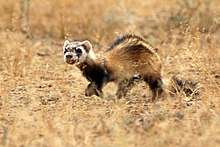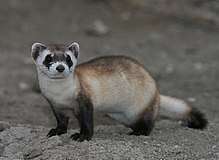Polecat
Polecat is a common name for mammals in the order Carnivora and subfamilies Galictinae and Mustelinae. Polecats do not form a single taxonomic rank (i.e., clade); the name is applied to several species with broad similarities (including having a dark mask-like marking across the face) to European polecats, the only polecat species native to the British Isles.
In the United States, the term polecat is sometimes applied to the black-footed ferret, a native member of the Mustelinae, and (loosely) to skunks, which are only distantly related.
Despite the name, polecats, being various caniform mustelids, are more closely related to dogs than cats, which is why they belong to the suborder Caniformia.
In Canada, the term polecat is sometimes applied to electric utility linemen. In Southern United States dialect, the term polecat is sometimes used as a colloquial nickname for a skunk.[1]
Taxonomy
According to the most recent taxonomic scheme proposing eight subfamilies within Mustelidae, the polecats are classified as:
Subfamily Galictinae
- Genus Ictonyx
- Striped polecat, I. striatus, (native to Central, Southern, and sub-Saharan Africa)
- Saharan striped polecat, I. libycus (Sahara)
- Genus Vormela
- Marbled polecat, V. peregusna (Southeastern Europe to western China)
Subfamily Mustelinae
- Genus Mustela
- Steppe polecat, M. eversmannii (Central and Eastern Europe, and Central Asia)
- American polecat (Black-footed ferret) M. nigripes (Southwest United States)
- European polecat, M. putorius (Western Eurasia and North Africa)
|
- Striped polecat
 Steppe polecat
Steppe polecat Black-footed ferret, the “American polecat”
Black-footed ferret, the “American polecat” European polecat
European polecat Marbled polecat
Marbled polecat
References
- "Skunk Fact Sheet" (PDF). The Georgia Department of Natural Resources Wildlife Resources Division.